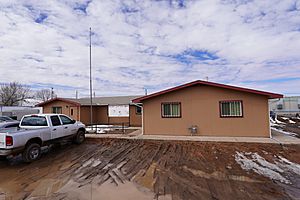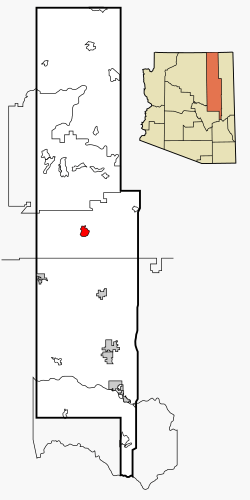Dilkon, Arizona facts for kids
Quick facts for kids
Dilkon, Arizona
|
|
|---|---|

Dilkon Chapter Admin building
|
|

Location in Navajo County and the state of Arizona
|
|
| Country | United States |
| State | Arizona |
| County | Navajo |
| Area | |
| • Total | 16.57 sq mi (42.93 km2) |
| • Land | 16.57 sq mi (42.92 km2) |
| • Water | 0.00 sq mi (0.00 km2) |
| Elevation | 5,885 ft (1,794 m) |
| Population
(2020)
|
|
| • Total | 1,194 |
| • Density | 72.04/sq mi (27.82/km2) |
| Time zone | UTC-7 (MST) |
| • Summer (DST) | UTC-6 (MDT) |
| ZIP code |
86047
|
| Area code(s) | 928 |
| FIPS code | 04-19280 |
| GNIS feature ID | 24399 |
Dilkon (Navajo: Tsézhin Dilkǫǫh) is a community in Navajo County, Arizona, United States. It is known as a "census-designated place" (CDP). This means it is a special area defined by the government for counting people. In 2020, about 1,194 people lived here. The name Dilkon comes from the Navajo language. It means "Smooth black rock" or "Bare surface."
Contents
Exploring Dilkon's Location
Dilkon is found at 35°21′38″N 110°18′56″W / 35.36056°N 110.31556°W. It sits on a large, high area called the Colorado Plateau. This plateau covers parts of Arizona and other states. Dilkon is also near the Hopi Buttes volcanic field. This area has many old volcanoes that are no longer active.
How Big is Dilkon?
The community of Dilkon covers a total area of about 16.8 square miles (44 km2). All of this area is land. There are no large lakes or rivers within its boundaries.
Who Lives in Dilkon?
Dilkon is home to a diverse group of people. The community has a unique mix of languages spoken at home.
Languages Spoken in Dilkon
| Languages (2000) | Percent |
|---|---|
| Spoke Navajo at home | 71.3% |
| Spoke English at home | 28.7% |
Population Changes Over Time
| Historical population | |||
|---|---|---|---|
| Census | Pop. | %± | |
| 2000 | 1,265 | — | |
| 2010 | 1,184 | −6.4% | |
| 2020 | 1,194 | 0.8% | |
| U.S. Decennial Census | |||
In 2000, there were 1,265 people living in Dilkon. By 2020, the population was 1,194. Most people in Dilkon are Native American. A small number of residents are White or from other backgrounds.
Community Life and Families
Many households in Dilkon have children under 18 living with them. The average household size is about four people. The community has a younger population compared to many other places. In 2000, almost half of the people were under 18 years old.
Learning and Schools in Dilkon
Students in Dilkon attend schools in nearby districts. Education is important for the community's future.
Local School Districts
Most of Dilkon is part of the Holbrook Unified School District. A smaller part of the community is served by the Joseph City Unified School District.
Schools Serving Dilkon Students
- Nearby Indian Wells Elementary School serves younger students from Dilkon.
- For middle and high school, students go to schools in Holbrook or Winslow.
- Holbrook Junior High School and Holbrook High School are in Holbrook.
- Winslow Junior High School and Winslow High School are in Winslow.
Protecting the Environment in Dilkon
In the late 1980s, the people of Dilkon faced a big challenge. A company wanted to build a large facility in their area. This led to a strong community effort to protect their land.
A Community Stands Up
In 1988, a company called Waste-Tech Services, Inc. wanted to build a recycling plant in Dilkon. They promised to create 200 jobs, which was exciting because many people in Dilkon needed work. However, the community soon learned that the plant would actually be a place to burn harmful waste. This waste would come from other states.
People were very upset when they found out. The Navajo people have deep respect for the land and their traditions. Burning waste, especially certain types, went against their beliefs.
Citizens Against Ruining Our Environment (CARE)
To fight against the plant, citizens formed a group called Citizens Against Ruining Our Environment (CARE). Lori Goodman and Abe Plummer helped start this group. CARE worked hard to show people the truth about the proposed plant.
On February 25, 1989, the company held a public meeting. They tried to convince the community that the project was safe. But the citizens had done their research. In a vote, 99 people said no to the project, and only six said yes.
A Victory for the Community
Because of the strong community voice, the tribal leaders listened. On March 6, they officially withdrew their approval for the project. CARE had successfully stopped the harmful waste facility from being built on their land.
This success inspired other Navajo environmental groups. They realized that working together could make a big difference. Many Native American communities often face challenges where harmful industries try to build on their lands. This is sometimes called "environmental racism." It happens when minority groups or those with less wealth are unfairly affected by pollution.
CARE's success led to the formation of a larger group called Diné CARE. "Diné" means "The People" in the Navajo language. This group continues to work to protect the land and health of the Navajo people.
See also
 In Spanish: Dilkon para niños
In Spanish: Dilkon para niños


